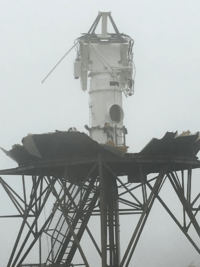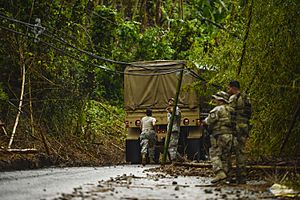Effects of Hurricane Maria in Puerto Rico facts for kids
| Category 4 major hurricane (SSHWS/NWS) | |
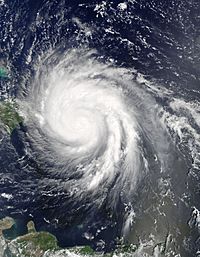
Hurricane Maria over Puerto Rico on September 20
|
|
| Duration | September 19–21, 2017 |
|---|---|
| Winds | 1-minute sustained: 155 mph (250 km/h) |
| Pressure | 920 mbar (hPa); 27.17 inHg |
| Fatalities | 2,982 (estimated) |
| Damage | $90 billion (2017 USD) |
| Areas affected | Puerto Rico |
| Part of the 2017 Atlantic hurricane season | |
Hurricane Maria was a super strong storm that hit the island of Puerto Rico in September 2017. It caused a huge problem for the people living there. Maria was one of the most powerful storms to hit Puerto Rico in almost 90 years. When it reached Puerto Rico on September 20, it was a very strong Category 4 hurricane. It brought a massive storm surge (a wall of ocean water), very heavy rains, and winds over 100 miles per hour. The hurricane destroyed homes, knocked out all the electricity, and caused a lot of damage, estimated at $90 billion. Sadly, about 2,982 people died because of the storm.
Contents
How Hurricane Maria Formed
Before Maria, Puerto Rico was already recovering from Hurricane Irma, which had hit just two weeks earlier. About 80,000 people still didn't have electricity when Maria was getting close.
Maria's Journey to Puerto Rico
Maria started as a tropical depression on September 16, far east of Barbados. The conditions were perfect for it to grow stronger. By September 17, it had become a hurricane. Over the next 24 hours, Maria quickly grew into a Category 5 hurricane. It hit the island of Dominica early on September 19.
Even after hitting Dominica, Maria stayed very strong. On September 20, it was near St. Croix with winds of 175 miles per hour.

Maria passed very close to St. Croix, about 20 miles away. Its outer part hit the island, but the strongest part stayed offshore. Later, the outer part of the storm hit Vieques, a small island near Puerto Rico. By this time, Maria had weakened a bit to a Category 4 storm.
Maria made landfall in Puerto Rico near Yabucoa around 10:15 AM UTC. Its winds were 155 miles per hour. This made it the second strongest hurricane ever recorded to hit Puerto Rico. The only stronger one was the 1928 San Felipe Segundo hurricane, which was a Category 5.
Puerto Rico's Power and Economy Before Maria
The company that provides electricity in Puerto Rico, PREPA, was already having money problems. Its equipment was old, with power plants being about 44 years old on average. This made the power system easy to damage during storms.
For ten years before Maria, Puerto Rico's economy was struggling. The government had a lot of debt. In early 2017, Puerto Rico had to declare bankruptcy because its public debt was $74 billion. Many businesses had left, and unemployment was high.
Getting Ready for the Storm
Weather experts from the National Hurricane Center did a great job predicting where Hurricane Maria would go. They warned early on September 16 that it would hit Puerto Rico as a major hurricane.
People in Puerto Rico were told to leave their homes and go to safe places. Officials opened 450 shelters on September 18. By September 19, at least 2,000 people had gone to these shelters to stay safe.
How Maria Affected Puerto Rico
| Precipitation | Storm | Location | Ref. | ||
|---|---|---|---|---|---|
| Rank | mm | in | |||
| 1 | 1,058.7 | 41.68 | T. D. #19 1970 | Jayuya 1 SE | |
| 2 | 845.6 | 33.29 | Eloise 1975 | Dos Bocas | |
| 3 | 804.4 | 31.67 | Isabel 1985 | Toro Negro Forest | |
| 4 | 775.0 | 30.51 | Georges 1998 | Jayuya | |
| 5 | 662.2 | 26.07 | Hazel 1954 | Toro Negro Tunnel | |
| 6 | 652.5 | 25.69 | Klaus 1984 | Guavate Camp | |
| 7 | 596.4 | 23.48 | Hortense 1996 | Cayey 1 NW | |
| 8 | 584.2 | 23.00 | 1899 San Ciriaco hurricane | Adjuntas | |
| 9 | 560.1 | 22.05 | Irene 2011 | Gurabo Abajo | |
| 10 | 504.4 | 19.86 | David 1979 | Cidra 3E | |
Hurricane Maria hit Puerto Rico on Wednesday, September 20. Strong winds and gusts were reported in the capital city of San Juan. After the storm hit, winds up to 118 miles per hour were recorded in other areas. There was also a lot of rain, with one area getting almost 38 inches!
Many parts of San Juan were flooded, with water reaching people's waists. The roofs of many buildings were blown off. The La Perla neighborhood in San Juan was almost completely destroyed. Cataño also had a lot of damage, with 80 percent of one neighborhood destroyed. The main airport in San Juan, Luis Muñoz Marín International Airport, was set to reopen on September 22.
Water released from the La Plata Lake Dam caused severe flooding in the town of Toa Baja. Thousands of people were trapped as floodwaters rose quickly, reaching up to 15 feet deep in some places. More than 2,000 people were rescued by the military. Sadly, at least eight people died from the flooding.
The hurricane completely destroyed the island's power system. All 3.4 million residents were left without electricity. The governor of Puerto Rico, Ricardo Rosselló, said it could take months to get power back in some areas. The mayor of San Juan, Carmen Yulín Cruz, thought some places might be without power for four to six months.
Communication was also very difficult. Most cell phone networks were down, and 85 percent of phone and internet cables were broken. Only one radio station stayed on the air during the storm.
The main weather radar for Puerto Rico was also destroyed. The cover for the radar antenna was blown away by the 130-mph winds. The 30-foot-wide radar dish was ripped off its base. This radar is very important for tracking storms, and it would take months to replace.
The nearby island of Vieques also had a lot of damage. Communication was mostly lost, and many buildings were destroyed.
Maria's strong winds also broke a large antenna at the Arecibo Observatory. This damaged the dish below it, making it much harder for the observatory to work until repairs are made.
Maria caused many factories in Puerto Rico to close, including those that make IV bags (bags used in hospitals for medicine). This led to a shortage of IV bags in the United States.
Cost of the Damage
On September 24, Governor Rosselló said that the damage from Hurricane Maria in Puerto Rico was more than $8 billion. He later estimated the total damage to be about $90 billion.
About 80 percent of Puerto Rico's farms were destroyed by the hurricane, with losses estimated at $780 million. Crops like plantains, bananas, and coffee were badly damaged. More than 90% of the chickens in Puerto Rico were also lost.
Emotional Impact of the Storm
After Hurricane Maria, many people felt sad and depressed. Being without power or water for a long time made existing mental health problems worse for some. It was hard to find food and clean water, even months after the storm. This made people feel hopeless. Many survivors said they would never forget the experience and still feel the emotional effects.
People were also very worried. On the western side of the island, there were rumors about water supplies, which made residents very anxious. Even when water service returned, it wasn't always reliable, and many still relied on bottled water.
Deaths Caused by Maria
| 2017 | 2016 | 2015 | |
| September | 2,838 | 2,366 | 2,242 |
| October | 2,119 | 2,353 | 2,379 |
| Total (Sept. and Oct.) | 4,957 | 4,719 | 4,621 |
For months after Maria, many people questioned the official number of deaths, which was 64 according to the Puerto Rico government. News organizations and scientists did their own research. For example, a CNN investigation found 499 hurricane-related deaths in just one month. Two scientists estimated the death toll to be 1,085 by the end of November 2017. They looked at how many more people died after the hurricane compared to normal.
On August 28, 2018, the Government of Puerto Rico changed the official death toll to 2,975 people. This makes Maria one of the deadliest hurricanes in United States history. This new number was based on a study ordered by the governor.
Aftermath and Recovery
There's a humanitarian emergency here in Puerto Rico.... This is an event without precedent.
The hurricane completely destroyed the power grid, leaving millions without electricity. Governor Ricardo Rosselló estimated the damage at $90 billion.
Even weeks and months after the hurricane, many people still didn't have power, clean water, or cell phone service.
- By September 26, 95% of the island had no power.
- By October 6, 89% still had no power.
- One month after the hurricane, 88% of the island (about 3 million people) were still without power.
- Three months later, 45% of Puerto Ricans still had no power.
The international relief group Oxfam helped in Puerto Rico. This was the first time they had helped on American soil since Hurricane Katrina in 2005.
One month after the hurricane, all hospitals were open, but most were running on backup generators. About half of the sewage treatment plants were still not working. Roads and bridges were also badly damaged. Only a small part of Puerto Rico's roads were open. Some towns were cut off, and supplies had to be delivered by helicopters.
There were also problems with getting fuel. Many gas stations were closed.
The Guajataca Dam was damaged, and people living nearby were told to leave because of the risk of flooding. Tens of thousands of people were in danger.
Puerto Rico was declared a Federal Disaster Zone. The Federal Emergency Management Agency (FEMA) started sending planes with supplies daily. Limited commercial flights also began again.
The U.S. military sent ships and thousands of marines to help with relief efforts. The United States Coast Guard sent 13 ships. Federal aid arrived on September 25 when major ports reopened. Cargo ships brought millions of liters of water, cots, and generators. The United States Air Force used large planes to deliver supplies. The United States Army Corps of Engineers worked on restoring the power grid. National Guard troops from many states also came to help.
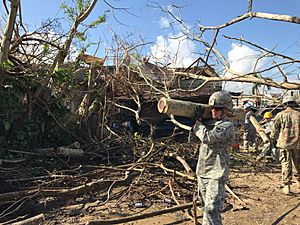
On September 29, a hospital ship called the USNS Comfort arrived to help. It had 250 beds, but at first, it wasn't used much because of problems with sending patients to the ship. Later, the ship docked in San Juan and treated many patients, including performing surgeries and helping with births.
By September 27, the Pentagon reopened two airfields and sent more help. However, many supplies were stuck at ports because there weren't enough truck drivers to move them. Communication problems made this worse.
Some companies started projects to bring solar power to Puerto Rico. They sent solar panels and battery systems to help restore electricity, especially to important community centers.
Many famous people, like Jennifer Aniston and Ricky Martin, donated money to help the victims of the hurricane.
By October 13, cruise ships started leaving from San Juan again. Also, there were reports that people were drinking water from a polluted site, but the water was later found to be safe.
By October 20, only a small part of the island had electricity. Many cell towers and gas stations were still not working. Thousands of people were still living in emergency shelters. By November 5, over 100,000 people had left Puerto Rico for the mainland.
Health Concerns: Leptospirosis Outbreak
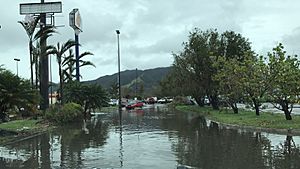
After the hurricane, there was a concern about an outbreak of leptospirosis. This is a bacterial infection that people can get from water contaminated with animal urine. Since many areas didn't have tap water, people had to use other water sources, like local streams, which might have been contaminated. By October 23, four people were thought to have died from the disease, and many others were suspected of being infected.
Recovery in 2018 and Beyond
Puerto Rico makes a lot of medical devices and medicines. The hurricane caused factories to close or slow down, which led to shortages of some medical supplies in the United States, like IV bags.
By the end of January 2018, about 450,000 people still didn't have power. In February, an explosion at a power station caused a big blackout in northern Puerto Rico, including San Juan.
By 2018, most of the island had electricity and water again, but outages still happened. In 2020, FEMA officials said that Puerto Rico was still not ready for another hurricane.
Even four years after the storm, most of the rebuilding work had not been finished. As of September 2021, FEMA had only given out 18% of the money set aside for the island. Many homes that lost their roofs during the hurricane were still using blue tarps instead of proper roofs.
|




